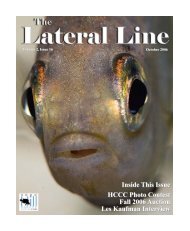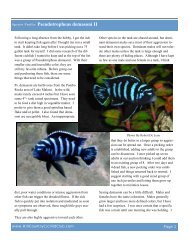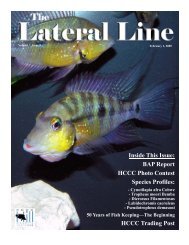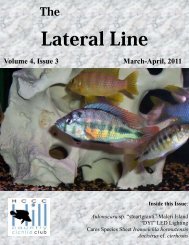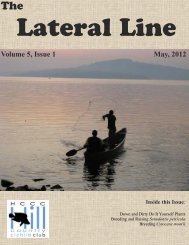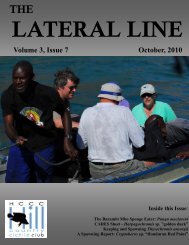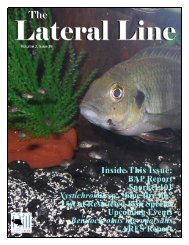Lateral Line July 2004-1.pub - Hill Country Cichlid Club
Lateral Line July 2004-1.pub - Hill Country Cichlid Club
Lateral Line July 2004-1.pub - Hill Country Cichlid Club
Create successful ePaper yourself
Turn your PDF publications into a flip-book with our unique Google optimized e-Paper software.
Volume 1, Issue 2 <strong>July</strong> 1, <strong>2004</strong>Inside This Issue:Insight on Barombi Mbo, CameroonThe Stand: Part IISetting Up a New AquariumAstatotilapia latifasciataHatching Baby Brine Shrimp
BAP Report<strong>July</strong> 1, <strong>2004</strong>INSIDE THIS ISSUE:Insight: Barombi Mbo 3The Stand: Part II 7New Aquariums Tips 9Species Profile 12Hatching BBS 13Available BAP Fry 14Upcoming Events:• ACA Annual Convention.<strong>July</strong> 22-25.• August Meeting TBAJune has been another successful month for our BreederAward Program. Although we only had two species earnpoints, one of the two was a first time spawn for the club.With many new people joining the club, it shouldn’t belong before we start seeing some new names on ourscoreboard. Don’t forget, many species are still availablefor purchase by HCCC members for the unbelievableprice of $5 for a group of six fry.Dave earned points for a Labidochromis caeruleus spawnand Robert for his Julidochromis dickfeldi spawn.Lets keep those fish healthy and spawning and don’t forgetto submit your BAP reports to earn your points.Picture of the MonthThis month is the first time that a noncichlidwas featured in our Picture of theMonth. This photograph was courtesy ofKarli Steeves, an up and coming photographer.I know what yourare thinking, andno, I didn’t put thepicture upsidedown nor was thephotographer hangingfrom her feet.This is a normalposition for thisfish.Current StandingsGreg 265Charles 110Duc 90Robert 85Paul 65Dave 60Lisa 60Brian 40Christina 25the wide maxillary barbells serve tosieve zooplankton which it ingests in aninverted position. Not yet spawned incaptivity, Hemisynodontis membranaceusis an interesting addition to mostcichlid aquariums.Cover Photo:Altolamprologuscompressecepsdwarfby Spencer JackFrom the familyMochokidae andnative to VoltaRiver and the NileRiver basin, Hemisynodontismembranaceusis a largercatfish growing to around 14 inches.Instantly recognizable by it's "mustache",Photo courtesy ofKarli Steeves
The <strong>Lateral</strong> <strong>Line</strong>Page 3A Little Insight on Barombi Mbo, Cameroon— by Greg SteevesMidway up the African continent's Atlantic coastsits the country of Cameroon. Near the town ofKumba is Lake Barombi Mbo. Barombi Mbo isone of many crater lakes that dot the southern portionof Cameroon. These aptly named crater lakesare basins formed over thousands of years on whatwere once active volcanoes. Some of the craterlakes sit atop active faults. Over time, pockets ofdeadly gas form in these craters. Seismic activityreleases the toxic vapor through the water and intothe air. In 1986, one such toxic burst occurred inanother Cameroonian crater lake, Lake Nyos. Thisevent made headlines as mysteriously causing thedeaths of 1500 people. Live stock, and nativefauna that were in thepath of this killercloud, also met a dismalfate. The nativepeople in the area surroundingLake BarombiMbo are awareof this phenomenonand believe it to be aspirit they havenamed "Mammy Water".In years past,animal sacrifices weremade to sootheMammy Water. It isto note that the toxicityof Barombi Mbo waters during these gas leaks must also bedetrimental to aquatic life, but over the thousands of years of evolutionhere, life has not only survived, but thrived and diversified.The native lake animals of Barombi Mbo are facing threats from afamiliar group of menaces. Trees in the area are being harvestedfor lumber and to make way for agricultural operations. The smalltributary that feeds from the lake is dammed up to supply water tonearby communities. Over harvesting the fish with modern nettingis probably the main culprit for decreased cichlid populations as oflate. All is not bleak though. The native people are developingsustainable harvesting of the fishery, reseeding the area with nativefoliage, and the protection of the entire lake as a natural reserve is ahave evolved.step in the right direction topreserving the region.Lake Barombi Mbo is asmall lake only 2.5 kilometerswide, but 110 metersdeep. As there is no largecurrent to turn the water,only the top portion (40 meters)contains acceptableoxygen levels to harbor vertebratelife. Still here, a richmostly endemic group ofcichlids (and other fish)Four endemic genera are found in BarombiMbo. These Include Konia with two species,Myaka and Pungu with one representive eachand Stomatepia with three. All of these fishare in the red list as critically endangered. Thecichlids of Lake Barombi Mbo are thought tohave originated from a Sarotherodon ancestor.This lineage has evolved over the past 10,000years.(Continued on page 4)
The <strong>Lateral</strong> <strong>Line</strong>Page 4The cichlids:Konia dikume (the local name forthis species) is unique species in thatwhen caught it hemorrhages due tohigh hemoglobin concentrations in itsblood. Growing to a length of 12 cm,Konia dikume is a silver coloredmouth brooder with faint vertical barring.This invertebrate feeder is oneof the rarer cichlids to find of the BarombiMbo species flock. It is hasthe deepest range of the endemiccichlids able to enter depths low inoxygen to feed.Ariel Bornstein www.blackwaterfish.comKonia eisentrauti is also an invertebrate feeder nativeto Barombi Mbo. Known as "konye" to the Nativepeople, Konia eisentrauti exhibits a differingadolescent vs. adult coloration and body shape. Abroken black line runs from the gill plate to the tailfin splitting the white belly region from the backwith black spots on a grey base running under thedorsal. The juvenile form is more elongated than theadult form. When adult, Konia eisentrauti is amainly silver fish with a solid black bar runningmid-body from the gill plate to the caudal area. Theadult body thickens and eisentrauti loses it's torpedoshaped profile.Ariel Bornstein www.blackwaterfish.comMyaka myaka is the only species from thisregion that I have personal experience with.Myakamyaka is the native name of this mostunusual cichlid and the only fish in the genus.In the wild Myaka myaka is a pelagic planctivore.In captivity, the myaka greedily acceptsanything that enters the water surface.Although the Myaka myaka only reaches 8cm, the fish has a nasty disposition with it'sown kind. I have housed my small colony of(Continued on page 5)
The <strong>Lateral</strong> <strong>Line</strong>five animals with a variety of Victorianand Tanganyikan cichlids, as well as catfish.Aggression seems to be interspecific.Myaka is somewhat mollyshaped with subdominant fish sporting asilver body coloration. Dominant maleswill turn jet black in the posterior portionof the body and retain the gleaming silverin the head past the gill plates. Theeye socket of Myakamyaka is red orange andreally stands out againstthe body coloration.This fish is, in my opinion,the most attractiveof the cichlids of BarombiMbo. I have hadmy dominant male stakeout breeding territoryand shimmer to prospectivefemales in thetypical mouthbroodermanner.Pungu, like Myaka, isanother monotypic genus containing thelone species, mclareni. The unique characteristicof Pungu maclareni is that thiscichlid is a sponge eater feeding on anendemic species of sponge(Corvospongilla thysi). The Pungumaclareni is abundant near shore and canreach 10 cm in length. This is anotherattractive cichlid in that the bright yellowbody coloration contrasts nicely with theblack blotched thorax and mid body line.Bright blue lips and edge tinge on thefins add the appeal of this mouthbrooder.Sarotherodon caroli grows to 18 cm.One of four Sarotherodon species fromLake Barombi Mbo, caroli exhibits differingfeeding habits in its juvenile andadult forms. Young Sarotherodon caroliare carnivorous cichlids while the adultforms feeds mainly on suspended phytoplankton.Another of Barombi Mbo's larger cichlidsis Sarotherodon linnellii. It too canreach in excess of 18cm. This species ischaracterized by a disproportionablylarge head. Males take on a metallicgreen hue, especially around the regionof the head, while females are typicallysilver with mostly colorless fins. TheNative people of the region refer to S.linnellii as"kippe".Sarotherodonlohbergeri is abi-parentalmouthbrooderfrom LakeBarombiMbo. Thebase colorationis a greyhue with ablackblotched midlaterallineextending the length of the body. Aslight yellow blaze runs from the fore-(Continued on page 6)Page 5Pungu mclareniOliver Lucanuswww.belowwater.comSarotherodonArial Bornsteinwww.blackwaterfish.com
The <strong>Lateral</strong> <strong>Line</strong> Page 6head along the base of the dorsal. Thelips and caudal fin are tinged blue.Sarotherodon lohbergeri grows to around11 cm and feeds mainly on filamentousalgae and the minute life forms that inhabitwithin. This cichlid is known asleka keppe by the native fisherman ofBarombi Mbo. Feeding strategy is similarto the mbuna of Lake Malawi and theTropheus of Tanganyika.Sarotherodon steinbachi is a light, nearlysolid yellow cichlid reaching 11 cm.This schooling fish is a sand sifter,plunging the substrate for organic morsels.Known to the people of the regionas "kululu", this is a rather unattractivefish in that it exhibits no bright colorationthat make the family cichlidae sopopular.Stomatepia mariae is a substrate spawningegg layer from Barombi Mbo. At 12cm S. mariae sports a copper flank dividedby a solid black horizontal band,and a silver belly. Breeding males exhibitbright yellow fins. S. mariae is apredator on other species.Stomatepia mongo is another mouthbrooding cichlid from Barombi Mbo andrecognizable by its long snout. S.mongo, which grows to 10 cm, is atanned copper color turning bright silverwhen in breeding coloration. The elongatedshape of the Stomatepia mongoresembles some of the detritus feeders ofLake Malawi. I cannot confirm thisfeeding strategy as I have also seen thisbody profilewith piscivoresaswell. Thereare also conflictingreportsof thiscichlid beingextinct in thewild howeverit appearsthat S.mongo israre due toits habit of living in deeper waters andnot extinct as some reports have suggested.Stomatepia pindu is probably the mostabundant cichlid from Lake BarombiMbo we see in the aquarium hobby.Reaching 9 cm, this little mouthbroodersports a solid jet black coloration whenin good condition. Coloration at timesrange from this beautiful black, to darkpurple, to a dull grey hue. Stomatepiapindu is a piscivore. Young S. pinduexhibit a tilapia spot on their dorsal thatvanishes upon adulthood.(Continued on page 7)Stomatepia pinduOliver Lucanuswww.belowwater.comStomatepia mongoArial Bornsteinwww.blackwaterfish.com
The <strong>Lateral</strong> <strong>Line</strong> Page 7Recently some of these cichlid specieshave been made available to the hobbyistfor the first time. There is much to learnconcerning husbandry associated withthese animals. Lake Barombi Mbo andmany of the crater lakes are small ecosystemsespecially susceptible to man'sinterference. It is hoped that by carefulanalysis and conservation measures, BarombiMbo and the other crater lakes ofCameroon, can be preserved and theunique ecosystems be held intact formany years to come.References and Acknowledgements:Bornstein, Ariel. Conversation and newsgroup posts (<strong>2004</strong>). http://www.blackwaterfish.com Permissionalphotographic contributions.Boorman, Lisa. Editorial and research contributions.Bunce, Nigel and Jim Hunt. The ScienceCorner, Deadly Gas From Killer Lakes(1986). University of Guelph.Goldstein, Dr. R. J. The <strong>Cichlid</strong> Fishies ofLake Barombi-Mbo, West Cameroon.Loiselle, Paul V. (1997) <strong>Cichlid</strong> News,Aquarium Husbandry of the Pindu, Stomatepiapindu Trewavas 1972.Lucanus, Oliver. Conversation and newsgroup posts (<strong>2004</strong>). http://www.belowwater.com/ Permissional photographiccontributions.McKinney Michael. The Underwater News,Pioneer Valley Aquarium Society.(December 2003)The Stand: Part IIThis is a continuation of an article Iwrote early on a need/desire for moretanks. I went into some detail of a standI planned on building to achieve thisgoal. As is typical of my projects, theplanning stage and final stage look nothingalike!! If you refer back to the Apriledition of the newsletter you will see adrawing I made for my stand and therequirements I wanted to meet. Theplans looked great on paper, except forone thing. I forgot to incorporate thethickness of the 2X4 and plywood in mydesign. The 4 ¼" combined thickness ofthe 2X4 and plywood would affect thedesign in that it really cut down on thedistance between shelves. I needed to beable to maneuver around the tanks formaintenance, catching fish, etc. Thestand would have been like 9 feet tall toaccomplish this based on my originalplans. So what I did was eliminate a— by Dave Hansenshelf. Obviously I wanted tanks morethan anything so I killed the dry goodand supply shelf.So I re-drew my plans and made a trip toHome Depot to pick up the wood. Thetotal came out to $69.48 for all the wood.Due to all the weight that the stand wasgoing to hold the need for square endswas very important. I didn't feel comfortabletrying to achieve this precisenesswith a circular saw so I moved the wholeproject over to my dad's house who has atable saw. I first built all the frames forthe shelves and then placed ¾" plywoodfor the surface. The only one I didn'tattach plywood to was the top shelf. Thetop was going to use a hinged cover andwould work on that later. Once theshelves were built I proceeded to cut the4 main posts. I attached the shelves to(Continued on page 8)
The <strong>Lateral</strong> <strong>Line</strong>Page 8the post using regular wood screws forthe time being. In the final product I uselag screws because I felt more confidentin the consistent qualityof the steel used in themversus regular screws.Here is a picture of theshelves and post joinedtogether.Once the shelves wereattached I started workingon the hinged shelf. Ibuilt the top so that thereare two separate sectionsthat hinge; each sectionruns half of the distanceof the shelf.The most important part was next. Howto finish this stand and have the wife approveenough to actually let me have itin the house. I had bought unfinishedpaneling to finish the sides and now proceededto install that.I next decided to build the flaps thatwould run the length of the bottom twoshelves to cover up the airspace betweenshelves. They would start at the top ofone shelf and run down to cover the toptrim of the tanks below on the next shelf.I cut them and installed knobs on them togive it a nice look and also easier to liftthe flap. I then sanded the hell out ofevery surface. Once that was finished Ibegin staining the wood. This tooklonger than I thought because the panelingand the plywood sucked up the stainpretty good. After giving the stain a dayto dry I shellacked the entire stand. Ilike the shine and also to help preventwater from ruining the wood. After thatI installed the flaps and stood back andwas pretty happy with the look.Turns out that was the easy part. Now Ihad to get it home. I called up a buddywho had a truck. He came over and welifted it into the back of his truck. Thisbeast was not light. The stand lookedlike it might rub on a few spots on thetruck so I grabbed a blanket and placedin some strategic locations. My buddythought I was trying to protect his truck.I started laughing. This truck has morescratch marks than paint on it. I said,"Your truck? I amworried about mystand!". We driveabout 20 miles to myhouse and unload andget into my livingroom. Now I need tomove the 55-gallonstand and tank. Thisis all about 6 pm on aMonday. We get thetank moved, slide thenew stand in placeand lift the 55 ontothe new stand. I amlike crap, I can't stophere. By the time Iget done draining,moving, refilling tanks it is about 1 am.The first words out of my wife's mouth(Continued on page 9)
The <strong>Lateral</strong> <strong>Line</strong> Page 9were WOW. That made it all worth theextra effort. We have really enjoyedhaving all the tanks together and are veryhappy with the final result. I took a picturethe next day. Since I have taken thepicture I have a tank running in the topright. Those supplies have been moved.I have another little project going for thesupplies and other stuff we tend to gatheras fish keepers. By the time it was allfinished my total cost was $101. 35.Now I need to figure out where I will putthe next one. I let my wife know I planon one stand for each lake : Any questionfeel free to ask.Tips for Setting Up Your New Aquarium: Part I— by Bob NuckolsOriginally appeared in FAMA March <strong>2004</strong>.Reprinted with permission from author.The first thing I consider is location. Decidewhere to put your aquarium bychoosing a location that is away fromdrafty areas and direct sunlight. Both canaffect the temperature of the tank anddirect sunlight can cause excessive algaegrowth. Be sure to choose a site that isclose enough to be observed from yourfavorite chair. If you put it in an obscurecorner you will not pay attention to itand the animals will suffer. I have a tankin my dining room that I really need tomove. No one stays in that room for anylength of time and the fish are kind ofignored, except for feeding time.A couple of other thoughts on location:be sure to pick a sturdy stand, the correct(Continued on page 10)
The <strong>Lateral</strong> <strong>Line</strong>Page 10size for your tank and make sure it islevel. Failure to do this can cause leakageor breakage. Both bad news! Youwill find it helpful if you pick a locationthat is close to an electrical outlet. If italso happens to be close to a watersource and a drain, all the better.Next, you will want to clean the aquarium.To clean the aquarium just wipe itinside and out with a clean wet towel. Iuse old baby diapers. Never use soap toclean your aquarium. Any remainingsoap residue will kill your fish. And becareful carrying a wet tank. Glass is slipperywhen wet.The third tip is filtration. The basic filtersystems are undergravel filters andpower filters. Most new tank set-upscome with one type or the other. Othertypes of filtration out there are cornerfilters, canister filters, fluidized bed filtersand wet/dry filters. No matter whichkind of filter you choose, it takes on averagesix to eight weeks to grow the bacteriato process the fish waste; or with anew product on the market, add live bacteria,wait overnight and add your fish.Be sure to follow the directions!The undergravel filter is the workhorseof aquarium filters for the last thirtyyears. They are easy to set up and fairlyeasy to maintain. Undergravel filters arebiological filters. They work by circulatingwater through the gravel taking oxygen-ladenwater from the water surfaceto the bacteria growing in the gravel.These bacteria process the fish waste asfast as the fish produce it. Unfortunately,this circulation also traps waste in thegravel as well, making it difficult to removefrom the gravel. Regular use of asiphon-type cleaner will help keep thefilter unclogged and working properly.Undergravel filters can be runusing either an air pump or a powerhead(which is just a small waterpump) to move the water through it.Outside power filters are probablythe next popular filtration systemsavailable today. Outside power filtersused to provide mechanical andchemical filtration only. In the "olddays" they were used in conjunctionwith undergravel filters to provideall three types of filtration - biological,mechanical, and chemical. Now, thebetter filters have a place to grow bacteria.Some have sponges, ceramic or plasticpieces or a spinning wheel as a placefor the bacteria to grow. Like the undergravelfilter, the bacteria grow to processthe fish waste as fast as the fish can produceit. Outside power filters also trapdirt mechanically and use carbon tochemically purify the water, which undergravelfilters cannot do.Another type of filter is the corner filter.These filters have been around since thefifties. This type of filter uses floss andcarbon as a filter media. This filter isprimarily a mechanical and chemicalfilter. The floss grows bacteria on it aswell as acting as the mechanical filter.Unfortunately, when the floss clogs andneeds to be replaced, the bacteria getthrown out as well. One way to getaround that is to use sponges, ceramic or(Continued on page 11)
The <strong>Lateral</strong> <strong>Line</strong> Page 11plastic pieces in the filter for the bacteriato grow on. Corner filters are generallyincluded in the economy type tank setups.I use them for quarantine tanks orfor breeding fish. I load them with gravelfrom an active undergravel filter bed so Ihave the bacteria instantly started.Canister filters are sealed containers thathave filter media to act as mechanical,chemical, and biological filtration. Theseare similar to an outside power filter butdon't hang off the side of your tank.Many people preferthat. However, the locationunder the tank andthe sealed lid make thisfilter more difficult tomaintain than the outsidepower filter.Fluidized beds aresolely biological filters.They use a small pumpto run water through apipe filled with sand. The sand grows thebacteria on it. These filters can process alot of waste in a small amount of space,and they are clog proof. The bacteria,once established, are able to respond toadditional loads quickly, making themuseful for those who have variable loadslike retail outlets or wholesalers. Thesefilters are difficult to operate and areprone to spew sand into your tank. Theyalso have virtually no current out of themat all, making additional air pumps, powerheadsor power filters necessary to ensureadequate water movement.Wet/dry filters are probably the mostcomplex looking filters on the marketbut are really quite simple. Water istaken out of the tank and run throughsome biological filter media. In addition,a sponge in the sump acts as a mechanicalfilter and a bag of carbon can be in-cluded to be a chemical filter.Because the biological mediais suspended in air, the bacteriahave an abundance of oxygenand can grow in terrificnumbers while in a smallspace. That makes these filtersvery efficient. Their under thetank location keeps the clutterto a minimum. I prefer thistype of filter because you areable to add protein skimmersand other additions easily.Whatever system you decide to usebe sure to read and follow the instructions.If you have any questionsbe sure to ask the salespersonwhere you purchased your filter.You will need to have gravel in thebottom of your tank. Gravel is necessaryto anchor live or artificialplants and is available in a myriad ofsizes and colors. It takes about one and ahalf pounds of gravel per gallon to havea depth of about two inches. Most gravelwill need to be rinsed before use, as ithas fine particles and dust in it. The easiestway to rinse the gravel is to put aboutfive pounds of gravel in a five-gallonbucket and rinse in a sink or bathtub. Stirthe gravel and empty the water as you gountil the water runs clear. Once clear,empty out the remaining water and carefullydump the gravel into the aquarium.Rinse the rest of the gravel this way untilyou are finished.Continued next issue:Decorations, conditioning, temperature,lighting, the nitrogen cycle and more.
The <strong>Lateral</strong> <strong>Line</strong> Page 12Species Profile: Astatotilapia latifasciata— by Robert De LeonThe Lake Victoria region cichlids havealways been a source of stress to me. Onone hand, the region produces some ofthe most beautiful cichlids. On the other,many are extremely aggressive,improperly identified, easily hybridizeand are generally hard tofind. Nonetheless, their colorsand appearance always draw meto them. Over the years I havekept various species with mixedresults, but one species that I willalways have warm memories of isAstatotilapia latifasciata (aka zebraobliquidens).Malawi mbunas. I fed them a combinationof spirulina based flake, pellets andfrozen food. They accepted everythinggreedily. They got along well with otherOriginally from Lake Kyona, A.latifasciata evolved in a swampyarea of the lake that is rapidly disappearing.Its plight issimilar to many otherspecies from the regionwhose habitats are beingdestroyed.I was attracted to thewonderful colorationof this species. Thebright red and yellowblotches in contrastwith the vertical barringon the males arenot only usual, butvery attractive. Femaleshave the barringbut lack the red and yellow color. WhenI first saw a picture of this fish, I knew itwould make a great addition to my tank.I obtained three juveniles and hoped forthe best. As they matured, it becameevident that luck was on my side. Themale and two females were housed in a75 gallon tank with other Victorians andfish, rarely a target and never aggressivetoward other species. Although the maleoccasionally chased his females, the aggressivewas never excessive and thefemales never appeared stressed. Thisspecies is definitely not as aggressive as(Continued on page 13)
The <strong>Lateral</strong> <strong>Line</strong> Page 13other Victorians.I was shocked one morning when I foundthe 1.5" female holding. She looked sosmall and I was sure she wouldn't holdher eggs the first time around. To mysurprise, she not only help the eggs, butshe had a large 20 fry clutch. The femaleand the fry were kept alone in a 10gallon tank. After releasing the fry, Isoon learned that A. latifasciata femalesare great mothers. Every night themother would take her fry back into hermouth. In the morning, she would releasethem again so they could feed. I lether stay with the fry for about a weekbefore returning her to the main tank.I’ve since read that the females willguard their fry for months.heard, they have a short reproductivewindow and they sure make the best ofit. Between the two females, I had newfry about every 3 weeks. I couldn't givethem away fast enough. Everyone Iknew got some of their offspring.A. latifasciata is a great starting speciesfor anyone thinking of trying out Victoriancichlids. They mix well with Malawicichlids, both haps and mbunas.The fry grew quickly and that was goodbecause it became apparent that thesefish are very prolific. From what I'veHatching Baby Brine ShrimpThere is no argument that newly-hatchedbaby brine shrimp (Artemia) is one ofthe best things you can feed Africancichlid fry, as well as adults in many species,such as shell-dwellers. Of coursethe lazy man's alternatives to live babybrine shrimp include the more expensivefrozen, flake and freeze-dried... but let'ssay you're both lazy and thrifty, but wantyour fish to have the best...There are about as many different methodsfor hatching and feeding baby brineas there are aquarists, and they rangefrom what I'm going to suggest, to themost technically advanced methods thatyield the highest hatching rates (such asthat which can be found here: http://www.argent-labs.com/artemia.htm).— by Lee Ann SteevesThose that fall somewhere in betweeninclude those cute little hatchery kits youcan buy at the pet store... IMO, too complicated,and you've defeated your purposeby spending so much on it.First, you need an area that's out of sight.I've NEVER seen an attractive brineshrimp hatchery set up. I don't recommendsetting it up in the living room andthen waiting to see if your spouse comesunglued. Find a warm place with an electricaloutlet that isn't frequently visitedby people that will be annoyed by a lightbeing on. Also needed: empty 3 liter popbottle, air pump, tubing, clothes pin andan incandescent desk lamp (or reflector,(Continued on page 14)For more information about the HCCC,visit our site at www.xdeleon.com/hccc
The <strong>Lateral</strong> <strong>Line</strong> Page 14or any incandescent light source that cansafely be placed very close to the bottle)...you'll also need artemia cysts(brine shrimp eggs) and uniodized salt(pickling salt is fine, so is aquarium salt).Fill the bottle about 2/3 full with warmdechlorinated water. Add about 3 tablespoonsof the salt and set up the airpump/air line. Poke the end of the airlinetubing into the bottle so that it is nearlyon the bottom. Use the clothespin to securethe tubing to the top of the bottle.Don't worry about how fast the water iscirculating... what is important is that itDOES circulate. Turn it on, make sureall is going well, then add about a teaspoonof eggs. Swirl the water around toget any that have stuck to the side, andput the light on it, very close to the bottle.This will warm the water so that theshrimp hatch. In 24 hours the water willlook pink, indicating that they havehatched.The hatch will be good for a couple ofdays... to harvest, I like to simply poursome water off into a container (like aplastic bowl) and let it settle, shining alight on the bottom. The empty cysts willgo to the top, and the hatchlings will migrateto the light... when you see a pinkcluster, use a turkey baster to siphonthem up.What you do next depends on whatyou're feeding. If you're feeding somethingthat doesn't tolerate salt, you'llneed to rinse the BBS in a brine shrimpnet or coffee filter. If you're feeding Africancichlids, you can probably just putthe shrimp directly into the tank withoutany trouble at all... that's what I do :)I don't worry about water temperature. Ifthere's a light on it, it's warm enough (aslong as it's not in a very cold room). Ifyou're not getting a good hatch, youmight monkey with the settings a bit...more or less salt, more wattage on thelight, or more lights... if it's still notworking, your eggs are probably old. I'venever had it not work though... GOODLUCK!Available BAP FishThe following species are currentlyavailable. Remember, you must be amember of the HCCC to purchase thesefry ($5 for 5-6 fry):—Haplochromis sp. Flameback—Paralabidochromis sp. "rock krib"—Neolamprologus olivaceous—Neolamprologus falcicula—Lepidiolamprologus hecqui—Neolamprologus multifasciatus—Haplochromis sp. "44"—Pelvichromis pulcherThis list changes frequently as new BAPfry are donated and as batches are takenby other members. Don’t miss out,check the discussion board under theMember Fish Exchange regularly.



